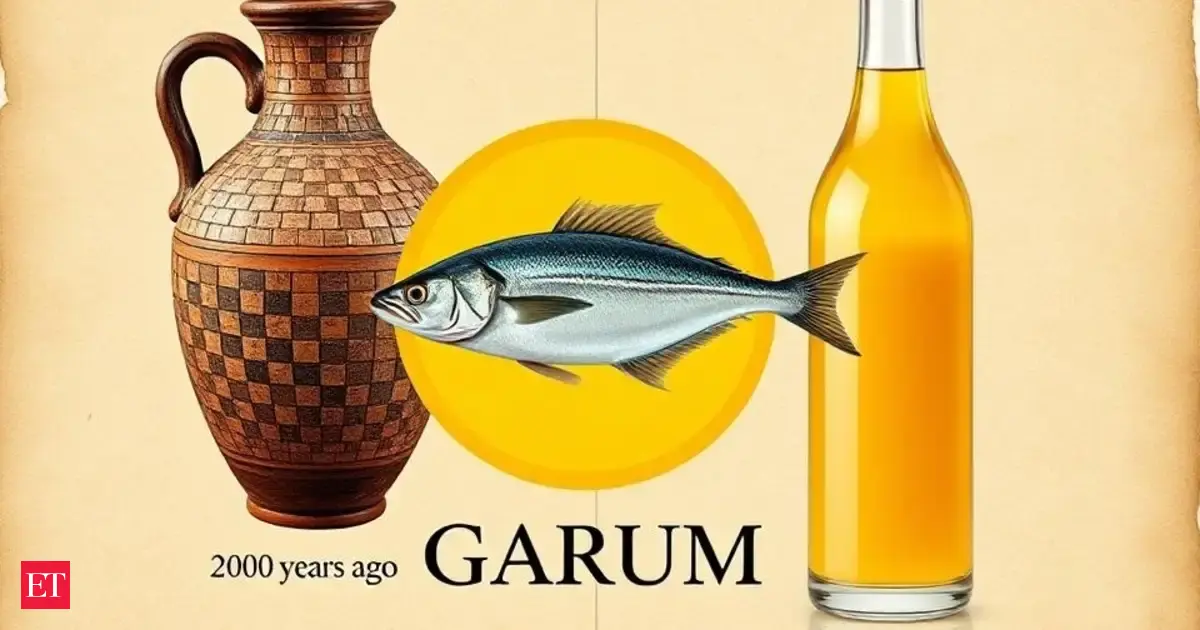By Global Desklast Updated
TIL CreativesNew genetic analysis reveals that Romans used sardines to make garum, some genetically similar to modern-day sardines still found off Spain’s coast.
Archaeologists have identified the fish used to make ‘garum,’ Rome’s favorite sauce, not by sight but by sequencing ancient DNA from fragmented bones found in a fish-salting vat in northwestern Spain. The breakthrough reveals that European sardines were a primary ingredient in the iconic fermented condiment. This new genetic evidence could open the door to knowing what Romans ate 2000 years ago and how they processed marine resources on a commercial scale.Also Read: Pacific Sleeper Sharks queue up to feed on cow in South China Sea; first-ever footage captures rare deep sea behaviorThis discovery, led by a multidisciplinary team of archaeologists and geneticists published in Antiquity, confirms long-standing theories about garum’s recipe.A genetic window into ancient Roman cuisineLive EventsThe remains were recovered from a cetaria, a coastal fish-processing plant, where garum was produced by fermenting small fish in salt.Researchers used a novel method of overlapping fragmented DNA sequences and aligning them with complete fish genomes to identify species that were previously unrecognizable using visual methods.“Fish bones are a frequent find in the archaeological record of the Roman period, yet their use in archaeogenetic studies is residual,” said Dr. Paula F. Campos from CIIMAR, Universidade do Porto. “Despite enduring conditions that promote DNA degradation, the methods we outline allow for the identification of species from these processed bones.”The marine economyThe study confirmed the use of sardines in ancient garum production and revealed striking genetic continuity with modern sardines found in the same region today. This continuity challenges assumptions about sardine populations’ mobility and genetic variability over two millennia.Garum was not merely a condiment but central to Roman cuisine and commerce. Its long shelf life and savory umami flavor made it a staple across Roman kitchens and a tradable commodity throughout the empire, especially from the coasts of Hispania (modern Spain and Portugal) and Tingitana (in present-day Morocco).While sardines dominated this site’s production, remains from other garum production sites indicate that herring, whiting, mackerel, and anchovy were also used, pointing to a more diverse marine resource base.Also Read: Volcano erupts in Japan as manga artist Ryo Tatsuki’s ‘Mega Disaster’ prophecy stokes fears and echoes Baba VangaThe Archaeology and EcologyThe team’s success opens doors for future archaeogenetic investigations into other ancient food production methods. Importantly, it also creates a new avenue for examining how ancient societies managed marine resources and how such exploitation has affected fish populations over time.“This might help identify with more precision some regional variations in the main ingredients of the ancient fish sauces and pastes,” said Annalisa Marzano of the University of Bologna, who was not involved in the study.By reconstructing ancient diets and trade networks, such research could inform current marineCampos and her team are now broadening their scope. “We are expanding the sampling locations to see if the results are consistent across the entire Roman Empire,” she noted. Archaeogenomics may soon unravel more connections between ancient food culture, ecology, and global trade patterns.The garum recipeThis study also supported the known technique of making garum in ancient Rome. Garum was made by layering small fish, often sardines or anchovies, with large amounts of salt in clay vats at coastal processing centers known as cercariae. The mixture was left to ferment naturally under the sun for weeks or months. As the fish broke down, a pungent, amber-colored liquid rose to the top.Also Read: Just one hot dog a day may increase risk of diabetes and colorectal Cancer, researchers warnThis liquid, strained and bottled, became garum, a prized condiment known for its rich umami flavor. The process was labor-intensive but sustainable, using every part of the fish and requiring no added preservatives thanks to the salt.Today, many home cooks and culinary historians are reviving the ancient recipe using modern tools and ingredients. In home kitchens, small batches of garum are often made using glass jars or food-safe containers, mixing fish scraps (like heads and bones) with salt and sometimes koji, a Japanese fermentation agent, to accelerate the breakdown. Fermentation typically takes a few weeks at room temperature, and while the process still yields a strong aroma, the end product is surprisingly mellow and versatile.(You can now subscribe to our Economic Times WhatsApp channel)
Read More News ongarumancient Roman cuisinefish sauce productionroman fish sauceroman fish sauce recipesardinesRoman Empiremarine resourcesancient dietsfermented fish
(Catch all the US News, UK News, Canada News, International Breaking News Events, and Latest News Updates on The Economic Times.) Download The Economic Times News App to get Daily International News Updates….moreless
(You can now subscribe to our Economic Times WhatsApp channel)Read More News ongarumancient Roman cuisinefish sauce productionroman fish sauceroman fish sauce recipesardinesRoman Empiremarine resourcesancient dietsfermented fish(Catch all the US News, UK News, Canada News, International Breaking News Events, and Latest News Updates on The Economic Times.) Download The Economic Times News App to get Daily International News Updates….moreless
Explore More Stories123
